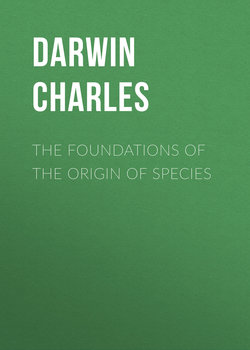Читать книгу The Foundations of the Origin of Species - Чарльз Дарвин, Darwin Charles - Страница 11
PART I
CHAPTER I
ON THE VARIATION OF ORGANIC BEINGS UNDER DOMESTICATION; AND ON THE PRINCIPLES OF SELECTION
ОглавлениеThe most favourable conditions for variation seem to be when organic beings are bred for many generations under domestication186: one may infer this from the simple fact of the vast number of races and breeds of almost every plant and animal, which has long been domesticated. Under certain conditions organic beings even during their individual lives become slightly altered from their usual form, size, or other characters: and many of the peculiarities thus acquired are transmitted to their offspring. Thus in animals, the size and vigour of body, fatness, period of maturity, habits of body or consensual movements, habits of mind and temper, are modified or acquired during the life of the individual187, and become inherited. There is reason to believe that when long exercise has given to certain muscles great development, or disuse has lessened them, that such development is also inherited. Food and climate will occasionally produce changes in the colour and texture of the external coverings of animals; and certain unknown conditions affect the horns of cattle in parts of Abyssinia; but whether these peculiarities, thus acquired during individual lives, have been inherited, I do not know. It appears certain that malconformation and lameness in horses, produced by too much work on hard roads, – that affections of the eyes in this animal probably caused by bad ventilation, – that tendencies towards many diseases in man, such as gout, caused by the course of life and ultimately producing changes of structure, and that many other diseases produced by unknown agencies, such as goitre, and the idiotcy resulting from it, all become hereditary.
It is very doubtful whether the flowers and leaf-buds, annually produced from the same bulb, root, or tree, can properly be considered as parts of the same individual, though in some respects they certainly seem to be so. If they are parts of an individual, plants also are subject to considerable changes during their individual lives. Most florist-flowers if neglected degenerate, that is, they lose some of their characters; so common is this, that trueness is often stated, as greatly enhancing the value of a variety188: tulips break their colours only after some years’ culture; some plants become double and others single, by neglect or care: these characters can be transmitted by cuttings or grafts, and in some cases by true or seminal propagation. Occasionally a single bud on a plant assumes at once a new and widely different character: thus it is certain that nectarines have been produced on peach trees and moss roses on provence roses; white currants on red currant bushes; flowers of a different colour from that of the stock, in Chrysanthemums, Dahlias, sweet-williams, Azaleas, &c., &c.; variegated leaf-buds on many trees, and other similar cases. These new characters appearing in single buds, can, like those lesser changes affecting the whole plant, be multiplied not only by cuttings and such means, but often likewise by true seminal generation.
The changes thus appearing during the lives of individual animals and plants are extremely rare compared with those which are congenital or which appear soon after birth. Slight differences thus arising are infinitely numerous: the proportions and form of every part of the frame, inside and outside, appear to vary in very slight degrees: anatomists dispute what is the “beau ideal” of the bones, the liver and kidneys, like painters do of the proportions of the face: the proverbial expression that no two animals or plants are born absolutely alike, is much truer when applied to those under domestication, than to those in a state of nature189. Besides these slight differences, single individuals are occasionally born considerably unlike in certain parts or in their whole structure to their parents: these are called by horticulturists and breeders “sports”; and are not uncommon except when very strongly marked. Such sports are known in some cases to have been parents of some of our domestic races; and such probably have been the parents of many other races, especially of those which in some senses may be called hereditary monsters; for instance where there is an additional limb, or where all the limbs are stunted (as in the Ancon sheep), or where a part is wanting, as in rumpless fowls and tailless dogs or cats190. The effects of external conditions on the size, colour and form, which can rarely and obscurely be detected during one individual life, become apparent after several generations: the slight differences, often hardly describable, which characterize the stock of different countries, and even of districts in the same country, seem to be due to such continued action.
186
The cumulative effect of domestication is insisted on in the Origin, see e. g. Origin, Ed. i. p. 7, vi. p. 8.
187
This type of variation passes into what he describes as the direct effect of conditions. Since they are due to causes acting during the adult life of the organism they might be called individual variations, but he uses this term for congenital variations, e. g. the differences discoverable in plants raised from seeds of the same pod (Origin, Ed. i. p. 45, vi. p. 53).
188
«It is not clear where the following note is meant to come»: Case of Orchis, – most remarkable as not long cultivated by seminal propagation. Case of varieties which soon acquire, like Ægilops and Carrot (and Maize) a certain general character and then go on varying.
189
Here, as in the MS. of 1842, the author is inclined to minimise the variation occurring in nature.
190
This is more strongly stated than in the Origin, Ed. i. p. 30.
